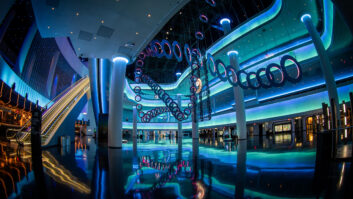
When Tech&Learning UK was invited to Polycom’s London demo suite earlier this year, we were ready for a runthrough of how RealPresence Immersive Studio would make life easier in the corporate world. What we weren’t expecting was to hear just how popular the specially designed environment that creates an immersive, interactive collaboration experience has been in the higher education market.
The demo was carried out with the help of the manufacturer’s New York colleagues.
Upon entering the meeting room two things are immediately striking: the soundproofing and the large screens displayed across the front wall.
The system is controlled via tablet – simply hit ‘Place call’, dial the number and you’re connected. Immediately, Caitlin Thompson, Polycom’s briefing manager in New York, appears on the centre screen to explain the system: “When we developed this product we really wanted to focus on the user experience so differing industries, whether it’s government, education, medical, or general enterprise, are really focused on how they want to collaborate.”
The result is an immersive environment that combines high-resolution displays with high-quality audio. The screen set up consists of an 18ft videowall, with three 84in 2K/4K-capable displays arranged at the front of the room. Above this is a 65in screen, which comes into play once content is shared – more of this later.
The camera set-up is located towards the bottom of the centre screen. Three cameras overlap and stitch the image to ensure that participants can get up, walk around and move freely, safe in the knowledge that they’ll remain visible to all. The positioning of the camera is also close to eye level which means maintaining eye contact throughout the call feels much more natural.
It is while people are moving around that the audio system comes into its own. The new set-up offers more than left/right directional sound or 3D voice. Dropped ceiling mics positioned throughout the room ensure sound is picked up at all points. Again this adds to the natural feel of the call – if the speaker moves when a participant is not looking, it is clear where they are now standing and the eye is naturally drawn into the correct position.
The sound is enhanced by the acoustic treatment to the back wall and ceiling. The space also features built-in audio mixers allowing for multiple channels of audio. This allows for breakout discussions within the room – a particularly useful tool in education settings where a seminar room can also be used as a more informal group discussion space and conversations can be siloed or focused on.
Ensuring the room is suitable for multiple uses was a key criteria in the design, according to Thompson: “It’s a multipurpose system and we always wanted to keep the rooms that way.” Another example of this is that chairs can also be placed on the screen side of the table – maintaining the room’s use as a traditional meeting room or a larger lecture space in the education environment.
The chairs themselves are slightly taller on the back row, meaning users can stand or sit and still be in shot. The room set-up is available as a single row option with nine places or a back row can add 12, creating a 21-seat room. This means 42 people can be visible in a two-venue single call. The limit on number of locations that can be hosted is 75,000.
Collaboration
The real strength of the system is its ability to display and share content. A whole range of content can be accommodated – from simple PowerPoint presentations to video content. Users can be hardwired into the system or sign in over WiFi to connect laptops/tablets and content can be shared from anywhere wirelessly. Users can also log in via a browser application to see content on their own devices – a useful tool when different class members are giving presentations.
Although content automatically defaults to be seen on the 65in screen this is easily customisable locally using a drag and drop system on the tablet. The idea is to “utilise the screens for whatever is most important at any given time”, according to Thompson.
Another element of the system is the ability to collaborate on top of whatever you’re sharing – so annotating, whiteboarding or blackboarding. This is managed by a screen that is currently not on camera, although work is being carried out to add a camera that will show the presenter annotating files. The annotations show on the screens in the London demo room, where we can take control and add our own notes to enhance the collaboration further.
Each of the three 84in screens can be divided into 16, so you can have 48 sites or people joining to create that command and control experience. To bring this about, users simply dial in a given code and meet on the bridge; the behind-the-scenes infrastructure stitches the layout according to what’s coming in and out. As sites are added the screens will continue to reframe accordingly.
Set-up time for the system is about five days, and “that’s a fairly conservative estimate”, according to Ray McGroarty, director, industry solutions and market development, EMEA, Polycom. As well as ease of install, ease of use and maintenance is central to the design.







